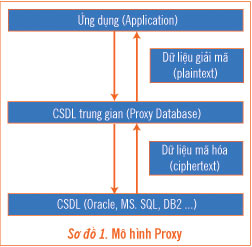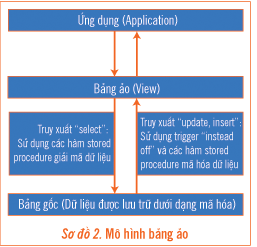Database security method
In the data security strategy, most companies now focus resources on data protection on the transmission line. Meanwhile, the data protection issue in the database (database, database) has not been properly concerned.
In fact, security problems with the database can seriously affect the company's reputation and customer relations. Security incidents of stealing 40 million credit cards of recent customers with Master Card and Visa Card have partly increased attention to database security solutions.
Within the scope of this article, the writer wants to present database security solutions by constructing the encryption layer.

The simplest solution to protect data in databases at the file level, against unauthorized access to database files is encryption. However, data encryption at this level is a 'get eaten, fall down' solution, this solution does not provide a level of security to access the database at table level (table), column ( column) and row (row). Another weakness of this solution is that anyone with database access can access all data in the database. This creates a serious risk, allowing objects with administrative rights (admin) to access all sensitive data. In addition, this solution is limited because it does not allow different permissions for database users.
The second solution, as opposed to the file-level encryption solution mentioned above, solves the problem of encryption at the application level. This solution handles data encryption before transferring data to the database. Key management and access issues are supported by the application. Querying data to the database will return data results in encrypted form and this data will be decoded by the application. This solution solves the problem of security separation and supports role-based security policies (Role Based Access Control - RBAC). However, coding on the application layer requires a comprehensive change of the application architecture, even requiring the application to be rewritten. This is a significant issue for companies with many applications running on many different database platforms.
From the analysis of the two solutions mentioned above, it is easy to see that an optimal database security solution should support the following main factors:
1. Support encryption at table, column, and row level data.
2. Support security policy to assign access to column data level, support RBAC.
3. Encryption mechanism does not affect current applications.
Here are two models that meet the above requirements, especially the third one.
1. Build intermediate database layer
In this model, an intermediate database (proxy) is built between the application and the original database (Diagram 1). This intermediate database plays the role of encrypting data before updating to the original database, and decoding the data before providing it to the application. The intermediate database also provides additional key management functions, user authentication and access licensing.
This solution allows to create more security functions for the database. However, the intermediate database model requires building a database application to replicate all functions of the original database.
Currently, on the market of database encryption products, Secure.Data of Protegrity (www. Protegrity.com) uses the above proxy model.
2. Use the mechanism available in the database
This model addresses column coding issues based on the following mechanisms:
a. The Stored Procedure functions in the database for coding and decoding functions
b. Using the View mechanism in the database creates virtual tables, replacing the actual encrypted tables.
c. The 'instead of' trigger mechanism is used to automate the encoding process from View to the original table.
In this model, the data in the original tables will be encrypted, the name of the original table is changed. A virtual table (View) is created with the name of the original table, the application will access this virtual table.

Retrieving data in this model can be summarized as follows (Diagram 2):
Data retrieval to the original table will be replaced by access to the virtual table.
Virtual tables are created to simulate data in the original table. When executing the 'select' command, the data will be decoded for the virtual table from the original (encrypted) table. When executing the 'Insert, Update' command, 'instead of' trigger will be executed and encrypted data to the original table.
Managing distribution of access to columns will be managed on virtual tables. In addition to the basic rights provided by the database, two new permissions are defined:
1. Users may only read data in encrypted form (ciphertext). This right is suitable for those who need to manage databases without reading the data content.
2. Users are allowed to read data in decoded form (plaintext).
The above solution has simple advantages, easy to develop. However, due to the limitations of view, trigger and data management mechanisms, this solution has the following limitations:
Index columns cannot be encrypted, thus restricting applications that need to support index
Encrypted data is large in size compared to the original data. This difference is not significant for text (text) data, but is significant for digital and binary data. For example, 1-byte numeric data will be increased by 2 bytes after encryption.
Database access speed decreases due to the implementation of encryption layer
Currently, on the market of database encryption products, DBEncrypt (www.appsecinc.com) and nCypher (www.ncypher.com) developed according to the above model.
CISSP - CISSP,
Project Manager, Global Cybersoft Vietnam
Refer
White Paper: Achieving Data Privacy Through Database Encryption.
White Paper: Protecting Oracle Database.
White Paper: Encryption of Data at Rest.
You should read it
- Test about database security P8
- Test on database security P6
- Oracle Database has more errors than SQL Server
- Learn about the role concept in SQL Server
- Use the ALTER DATABASE command to migrate DATABASE in SQL Server
- Open the Chinese malicious database
- Test of database security P10
- Test of database security P9
May be interested
- Test of database security P9
 please read your knowledge and multiple choice questions about the database that the network administrator has edited below. certainly with this useful knowledge will help you work more effectively.
please read your knowledge and multiple choice questions about the database that the network administrator has edited below. certainly with this useful knowledge will help you work more effectively. - Method in HTTP
 the set of common methods for http / 1.1 is defined below and this set of settings can be expanded based on the requirements. these method names are case-sensitive and they must be used in uppercase.
the set of common methods for http / 1.1 is defined below and this set of settings can be expanded based on the requirements. these method names are case-sensitive and they must be used in uppercase. - What you need to know about an information security analyst
 due to the increase in network attacks and database breaches, companies are becoming more and more cautious about their data security issues.
due to the increase in network attacks and database breaches, companies are becoming more and more cautious about their data security issues. - New worm variant exploits Oracle errors
 the malicious code has the ability to exploit security vulnerabilities and cause serious damage to previously distributed oracle database software that has been widely modified and redistributed on the internet, ringing a scene ring. new newspaper about one
the malicious code has the ability to exploit security vulnerabilities and cause serious damage to previously distributed oracle database software that has been widely modified and redistributed on the internet, ringing a scene ring. new newspaper about one - Test on database security P7
 please read your knowledge of the database through the multiple choice questions below. hope with these interesting questions will give you lots of useful information.
please read your knowledge of the database through the multiple choice questions below. hope with these interesting questions will give you lots of useful information. - Test about database security P13
 please read your knowledge of the database through the multiple choice questions below. hope with these interesting questions will give you lots of useful information.
please read your knowledge of the database through the multiple choice questions below. hope with these interesting questions will give you lots of useful information. - How to create a database in MySQL
 mysql can be a scary program. all commands must go through the command line interpreter program (command prompt) without any intuitive interface. therefore, the basic knowledge of how to create and manipulate on a database in mysql can save you time and avoid nuisance.
mysql can be a scary program. all commands must go through the command line interpreter program (command prompt) without any intuitive interface. therefore, the basic knowledge of how to create and manipulate on a database in mysql can save you time and avoid nuisance. - New attack method 'bypasses' security software
 a new, supposedly daring, dangerous and sophisticated attack method, with the ability to 'bypass' many windows security programs easily
a new, supposedly daring, dangerous and sophisticated attack method, with the ability to 'bypass' many windows security programs easily - How to recover the database in MS SQL Server
 simply put, this is the process of retrieving the backup file and returning it to the database.
simply put, this is the process of retrieving the backup file and returning it to the database. - Overview of the Access 2010 tutorial series
 access 2010 is a database creation and management program. to better understand access, you must first understand the database.
access 2010 is a database creation and management program. to better understand access, you must first understand the database.










 Data safes for businesses
Data safes for businesses Display Vietnamese Unicode text in Access 2000
Display Vietnamese Unicode text in Access 2000 Build a simple dictionary application
Build a simple dictionary application Create more desktops with Multi Desktop 1.5
Create more desktops with Multi Desktop 1.5 Secure programming of Access database
Secure programming of Access database Building Content Management System with ASP - Part I
Building Content Management System with ASP - Part I